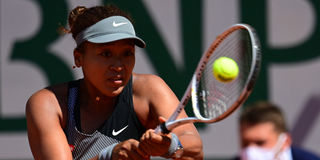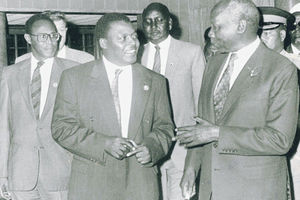Naomi Osaka is merely giving the dog a bad name

Japan's Naomi Osaka returns the ball to Romania's Patricia Maria Tig during their women's singles first round match on Day 1 of The Roland Garros 2021 French Open in Paris on May 30, 2021.
What you need to know:
- In my book, it all amounts to giving the dog a name then killing it. Sadly, we, the journalists, are the dogs in this case.
The English language, as we Kenyans often say, may have arrived on these shores on a primeval ship, but Dholuo, my mother tongue, has managed to coin indigenous translations for all English words under the sun.
In Dholuo, a motorcar is not ‘gari’ but ‘nyambruko’, a radio is ‘nyakalondo’, a policeman is ‘obila’ and money is ‘otonglo’. But those are the easy ones.
The Dholuo language even has translations for the more complex cardinal directions that we of the GHC era learnt so many years ago in primary school. North is ‘Nyanduat’, South is ‘Milambo’, East is ‘Ugwe’ and West is ‘Yimbo’.
For the benefit of the ‘xaxa’ generation, I must hasten to clarify that GHC stands for Geography, History and Civics, an ancient mash-up of three different subjects that we were painfully put through in school. I’m not sure what kids nowadays learn in its place.
Anyway, back to Dholuo and its rich vocabulary. How many Kenyans tribes out there actually have an equivalent word for journalists? I leave it to you to find out, but in Dholuo journalists are ‘Jofuambo Weche’ or simply ‘Jofuambo’ in short.
This particular translation, though, is somewhat irksome for its salient association of journalism with ‘information peddling’ or to put it more bluntly, ‘rumour mongering’.
But that inaccurate translation is fairly palatable in a country where, in the eyes of the bigoted political class, the usefulness of journalists doesn’t go beyond churning out ‘meat-wrapping’ material.
This brings me to my point. We journalists may hate to admit it, but journalism has become the most despicable and thankless profession in the world. Ironically, our professional brief is pretty straightforward; to inform, entertain and educate our audiences. Anything in between is merely for aesthetics.
What makes it all hard is that in the digital era that we live in, journalists must on a minute-by-minute keep satiating an information-hungry audience that is not only hard to please but also highly opinionated and overly critical of the bearers of the news.
The situation has been exacerbated by digital disruption that has turned every Tom, Dick and Harry with a smartphone in hand into a journalist. The mainstream media has now been caught in an exhausting rat race with social media, which the latter is winning by a mile.
To paraphrase 19th century English poet, Rudyard Kipling, in his famous poem If, even when we journalists get it right (which we mostly do), we still “bear to hear the truth we’ve spoken (written) twisted by knaves to make a trap for fools” by conniving sources and manipulative news subjects, most notably politicians and their gun-for-hire keyboard warriors.
Lately, even sports men and women have joined this bandwagon of news subjects who are all too eager to blame it all on journalists, as was the recent case of world number two female tennis player Naomi Osaka at the just concluded French Open.
It was utterly preposterous for her to blame journalists for her mental health issues, then proceeding to engage the tournament organisers in an unnecessary standoff with a churlish media boycott.
It’s a wishy-washy narrative that I don’t buy one single bit. If it was true, then all public figures in the world – politicians, entertainers, musicians and celebrities – would be battling serious mental health problems.
In my book, it all amounts to giving the dog a bad name, then killing it. Sadly, we, the journalists, are the dogs in this case.




